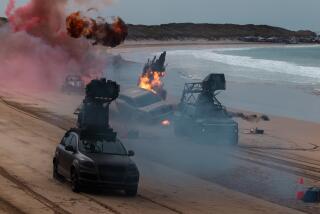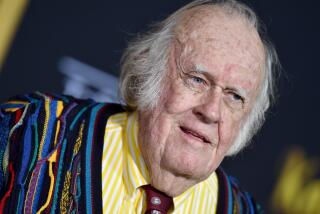Hal Needham dies at 82; legendary Hollywood stuntman turned director
Stuntman and director Hal Needham spoke with a down-home twang but was as Hollywood as air kisses and car chases — and had the scars to prove it.
In a career that spanned hundreds of TV episodes and feature films, he tumbled down cliffs, leaped off boulders, jumped from planes, tottered off balconies and plummeted from towers. He was rattled in blasts, was blistered in fires and broke 56 bones — including his back, twice.
But he maintained a sunny outlook, even after plunging into the unknown territory of film directing.
“I can go back and fall on my head any time,” he told an interviewer in 1979.
Needham, 82, a legendary Hollywood stuntman before becoming the director of frothy, adrenaline-pumped films including “Smokey and the Bandit” and “The Cannonball Run,” died Friday in Los Angeles, said a family spokesman, who declined to give the cause of death.
In 2012, Needham received a Governor’s Award from the Academy of Motion Picture Arts and Sciences. The academy, which gives no Oscars for stunt work, cited Needham as “an innovator, mentor and master technician who elevated his craft to an art and made the impossible look easy.”
Needham helped design a number of devices aimed at making stunts both safer and more spectacular, including a pressure-plate gizmo that could hurl an actor into the air as a car seemed to hit him or an explosion went off nearby. In 1986, he and collaborator William L. Frederick received the academy’s Scientific and Engineering Award for developing the Shotmaker Elite camera car and crane, an invention used for more efficient shooting of action sequences.
For relaxation, Needham enjoyed race cars. He owned the Budweiser Rocket Car, which Air Force radar clocked at more than 739 mph. Needham claimed it was the first land vehicle to break the sound barrier, although the achievement went unrecognized by any sanctioning body.
Despite a taste for gold chains, medallions and even a pendant made from a gold toothpick given to him by actress Ann-Margret, Needham was known as a modest, plain-spoken man. In interviews, he would ask to be forgiven for a little “braggadocio” when telling some of his larger-than-life Hollywood tales — like the time he taught John Wayne how to throw a punch.
It was on the set of a 1969 western — “The Undefeated” — and, because of the camera’s position just behind the character he was supposed to be decking, Wayne had a hard time delivering a fake punch that looked believable.
“Duke was throwing a straight-on jab by the side of the guy’s face. You could tell he was missing the guy by a mile,” Needham wrote in his 2011 memoir, “Stuntman! My Car-Crashing, Plane-Jumping, Bone-Breaking, Death-Defying Hollywood Life.”
Without being asked, Needham stepped in and demonstrated an ever-so-close roundhouse punch — a lesson for which the Duke did not thank him. Later on, in a bar, Wayne grabbed the stuntman in a headlock and loudly berated him for showing him up in front of the crew.
“A few seconds passed and I wasn’t sure whether he was going to release me or tear my head off,” Needham wrote. Wayne told him to keep the good ideas coming and keep the bad ones to himself. Then he gave his captive “a friendly Dutch rub” and let him go, saying: “Get it done, Needham.”
The two remained friends until Wayne’s death in 1979.
The son of sharecroppers, Needham was born in Memphis, Tenn., on March 6, 1931, and spent most of his childhood so deep in the Ozarks that, as he liked to joke, “You had to pump the sunshine to us.”
Dropping out of school after eighth grade, he worked as a tree trimmer in St. Louis before joining the Army’s 82nd Airborne Division in 1951. Three years and many jumps later, he left the service and headed west with three pairs of jeans, six T-shirts, a buddy and no particular plan.
“I knew I wasn’t qualified to be a brain surgeon and I figured I would have to do something dangerous to make money,” he wrote in his memoir.
A chance meeting with a fellow paratrooper at a root beer stand in Orange County led to Needham’s first stunt: jumping off a low-flying Cessna 150 to knock a rider off a galloping horse for the TV request show “You Asked for It.” Clinging to the landing gear, Needham chose just the right moment to swoop onto the rider nearly 20 feet below.
In a 2010 interview with Popular Mechanics, he rated that stunt as one of his six greatest.
“My main concern was to get at least one hand on that guy, so that it would look like I was pulling him off that horse,” he said. “But the main thing was, don’t hit that horse. Because if I did, there could have been some kind of wreck.”
Before long, Needham was actor Richard Boone’s stunt double on “Have Gun — Will Travel,” a job that lasted six years and opened the door to a long career of crashes, explosions, stampedes and countless good-ol’-boy car chases.
The first time Needham broke his back was in a 1974 promotion for General Motors. The idea was to rig a GM pickup with a rocket, roar up a ramp at 90 mph and vault 140 feet across a canal.
“The nose of the truck kept rising, and I couldn’t see the ramp or the ground on the other side of the canal, just blue sky through the windshield,” Needham wrote.
When the truck crashed down, it crumpled nearly in half and Needham had to be pried out.
Four years later, he broke his back again. On a dry lakebed outside Los Angeles, he tried to flip a car for a stunt in John Wayne’s “McQ.” Using a homemade cannon aimed at a hole in the car’s floor, he blasted a chunk of wood into the ground, figuring the car would bounce up and turn over. It worked all too well; the blast, a lot more forceful than Needham anticipated, catapulted car and driver 30 feet into the air.
Needham’s directing career started in 1977 with “Smokey and the Bandit” — the first in a string of mostly successful movies he made with Burt Reynolds, a friend so close that Needham lived in his guest house for 12 years. The two also owned a NASCAR team.
Critics weren’t crazy about the films, which included “Hooper” and “Stroker Ace.” In 1981, Roger Ebert called “The Cannonball Run” the story of a wild, cross-country car race, “an abdication of artistic responsibility at the lowest possible level of ambition.”
“In other words,” Ebert wrote, “they didn’t even care enough to make a good, lousy movie.”
Needham didn’t take such criticism too seriously. “Cannonball Run” earned more than $72 million and was the year’s sixth top-grossing movie. Needham even featured withering excerpts from its bad reviews in a Variety newspaper ad — right next to a photo of himself sitting on a wheelbarrow laden with cash.
In 2011, NPR’s Terry Gross asked him to engage in a moment of introspection.
“So when you turn on the TV and one of your films or TV shows is on and there you are risking your life doing a stunt, what goes through your mind?” she asked.
“I got a residual coming,” he said with a laugh.
Information on survivors was unavailable.
More to Read
Start your day right
Sign up for Essential California for the L.A. Times biggest news, features and recommendations in your inbox six days a week.
You may occasionally receive promotional content from the Los Angeles Times.







